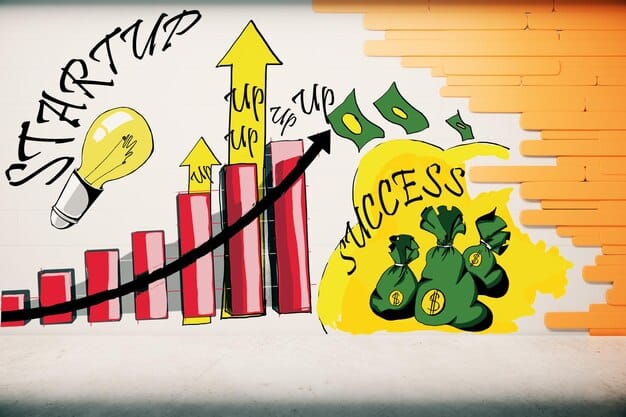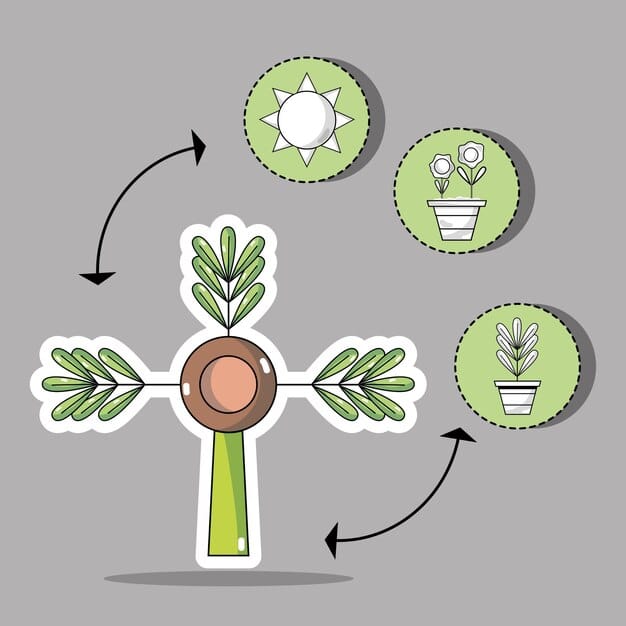Seed Round vs. Series A: Understanding Funding for US Startups

Navigating the complexities of startup funding, Seed Round vs. Series A, is crucial for US entrepreneurs, as each stage presents distinct investor expectations, capital amounts, and strategic objectives essential for scaling a venture from an idea to market-ready and beyond.
For US startups, understanding the nuances between a seed round vs. Series A funding is not merely a formality; it is a strategic imperative. These initial capital injections define a venture’s trajectory, dictating its resources, growth potential, and ultimate success in competitive markets. Delving into these stages reveals more than just financial figures; it uncovers the distinct expectations, milestones, and investor profiles that shape the entrepreneurial journey.
The Foundational Seed Round: Nurturing the Idea
The seed round represents the very first significant external capital injection a startup receives. Its primary purpose revolves around transforming an innovative idea into a tangible, viable product or service. At this stage, risks are inherently high, and potential returns are equally substantial. Investors aren’t just buying into a business plan; they are investing in the vision, the founding team’s potential, and the nascent market opportunity.
Typically, seed funding helps cover initial operational costs, product development, market research, and team expansion. It allows founders to build a minimum viable product (MVP), conduct initial market validation, and demonstrate early traction. This early capital is often sourced from angel investors, incubators, accelerators, or even friends and family, all of whom typically take a significant leap of faith.
Key Characteristics of Seed Funding
Seed rounds are characterized by their relatively smaller size compared to later stages, reflecting the early-stage nature of the venture. The focus is squarely on foundational development and validation.
- Capital Range: Generally from $50,000 to $2 million, though outliers exist.
- Investor Profile: Angel investors, venture capitalists (VCS) focused on early stages, family offices, and accelerators.
- Valuation: Highly subjective and often based on potential, team strength, and market size rather than established revenue.
- Dilution: Founders typically experience significant dilution during this stage, trading equity for critical early capital.
The documentation for seed rounds tends to be simpler, often involving convertible notes or SAFEs (Simple Agreement for Future Equity), which defer valuation until a later, more established funding round. This simplicity aims to reduce legal costs and accelerate the funding process for nascent companies.
Milestones to Achieve with Seed Capital
The success of a seed round is measured by the startup’s ability to hit specific, predefined milestones that de-risk the venture and make it more attractive for subsequent funding. These milestones are often qualitative rather than quantitative.
- Product Development: Launching an MVP, demonstrating core functionality, and gathering initial user feedback.
- Market Validation: Confirming a clear market demand for the product or service, often through pilot programs or initial user acquisition.
- Team Building: Expanding the core team with key hires essential for product development and initial operations.
- Early Traction: Showing initial signs of user growth, engagement, or revenue, even if minimal.
Ultimately, a successful seed round positions the startup for the next major leap: the Series A. It’s about proving the concept and building the fundamental infrastructure needed for scalable growth.
Series A: Scaling the Validated Model
If the seed round is about finding product-market fit, Series A funding is about proving that the fit can be scaled. This stage typically occurs when a startup has demonstrated strong traction, a validated business model, and a clear path to significant revenue growth. Series A investors are looking for established metrics and a defensible competitive advantage.
The capital raised in a Series A round is substantially larger than seed funding. It is used to refine the product, expand market reach, hire senior talent, and build out sales and marketing infrastructure. The goal is to evolve from a promising startup into a sustainable, growing business.
Hallmarks of a Series A Round
Series A rounds frequently involve institutional venture capital firms that bring not only capital but also invaluable expertise, networks, and strategic guidance. These investors are often sector-specific and have a proven track record of scaling similar ventures.
- Capital Range: Typically between $2 million and $15 million, but can extend much higher for capital-intensive ventures.
- Investor Profile: Dedicated venture capital firms, corporate venture arms, and larger angel syndicates.
- Valuation: Based on concrete metrics like revenue, user growth, customer acquisition costs (CAC), and lifetime value (LTV).
- Due Diligence: Significantly more extensive than seed rounds, focusing on financial performance, legal structures, and market potential.
Investment terms become more complex in Series A, often involving preferred stock with liquidation preferences, anti-dilution provisions, and board representation. This reflects the larger sums of capital at stake and the investors’ need for greater protection and influence.
Critical Milestones for Series A Success
The transition from seed to Series A demands a shift from proving concept to demonstrating scalability and sustained growth. The milestones are quantitative and often involve significant market penetration.
- Revenue Growth: Demonstrating consistent and accelerating revenue.
- Customer Acquisition: Proving efficient and repeatable customer acquisition channels.
- Unit Economics: Showing positive unit economics (e.g., LTV > CAC).
- Operational Scalability: Building out the team and internal processes to support rapid expansion.
Successfully closing a Series A round signifies a major validation of the startup’s potential and provides the fuel needed to execute ambitious growth plans. It’s a pivotal moment that separates promising ventures from those ready to dominate their respective markets.
Differentiating Investor Expectations: Seed vs. Series A
The shift in funding stages brings a fundamental change in what investors expect and analyze. While seed investors are often betting on a team and a nascent idea, Series A investors demand concrete proof of concept and scalability.
In a seed round, investors tolerate a higher degree of ambiguity. They understand that the product may still be evolving, and the business model might not be fully crystallized. Their investment is a bet on the founders’ ability to iterate, find product-market fit, and navigate early challenges. It’s about potential. They value passion, adaptability, and a clear vision for solving a significant problem.
For Series A, the narrative changes significantly. Investors require a more mature, data-driven pitch. They need to see a track record of achievement, a solid understanding of market dynamics, and a clear roadmap for scaling. This means robust financial projections, detailed go-to-market strategies, and a proven ability to attract and retain customers. The Series A investor is looking at not just potential, but demonstrated performance and a clear path to exit.
The Team Profile: Evolution Across Stages
The composition and experience of the founding team evolve considerably from the seed to Series A stages. In the seed phase, a small, agile team, often comprising co-founders with complementary skills, drives the initial vision.
- Seed Team Focus: High passion, hands-on execution, strong technical or product skills, and a deep understanding of the problem they are solving.
- Series A Team Focus: Expansion into functional departments, hiring experienced leadership in areas like sales, marketing, finance, and operations. Focus shifts from pure execution to building scalable processes and managing growth.
Series A investors pay close attention to whether the founding team has demonstrated the ability to attract and integrate top talent, recognizing that scaling demands a more diverse and experienced leadership structure.
Valuation Methodologies: From Art to Science
Valuation in early-stage funding is notoriously complex and often more of an art than a science, especially in the seed round. Without significant revenue or established metrics, seed valuations heavily rely on qualitative factors.
Seed valuations are influenced by market comparables (similar early-stage deals), the perceived size of the market opportunity, the uniqueness of the technology, and the pedigree of the founding team. Negotiation often plays a significant role, with investors and founders aiming for a fair price that incentivizes both parties.
By Series A, valuation becomes significantly more data-driven. While market comparables remain important, the focus shifts to the company’s actual performance. Key metrics such as recurring revenue (ARR/MRR), churn rates, customer acquisition costs, and gross margins provide a strong basis for calculating present value and projecting future growth. Investors will analyze unit economics rigorously to ensure the business model is inherently profitable as it scales. The process becomes less about projections and more about verified performance, reducing the speculative element significantly.
Legal and Structural Differences
The legal framework surrounding seed and Series A rounds also exhibits key differences, primarily driven by the increasing complexity and capital involved.
Seed Round Legalities:
- Convertible Instruments: Often use simpler instruments like convertible notes or SAFEs. These debt-like instruments convert into equity at a later funding round, typically with a discount or valuation cap built-in. This avoids the need for a formal valuation at a very early stage, streamlining the process.
- Limited Diligence: Legal due diligence is less exhaustive, focusing on basic corporate formation, intellectual property assignments, and avoiding immediate red flags.
Series A Legalities:
- Preferred Stock: Almost exclusively involves the issuance of preferred stock. This type of stock carries special rights and preferences over common stock, such as liquidation preferences (getting their money back before common shareholders in an exit event), anti-dilution protection, and board representation rights.
- Extensive Due Diligence: Legal due diligence becomes comprehensive, scrutinizing all aspects of the business: intellectual property, contracts, litigation, regulatory compliance, and financial records.
- Shareholder Agreements: Detailed shareholder agreements are negotiated, outlining investor rights, protective provisions, information rights, and conditions for future funding rounds or exit events.
The legal complexity scales with the capital injected, reflecting the advanced stage of the business and the institutional nature of Series A investors.

Beyond Funding: Developing a Strategic Partnership
While the immediate goal of both seed and Series A rounds is capital acquisition, wise founders view these interactions as opportunities to forge strategic partnerships. The right investors bring more than just money; they offer invaluable guidance, industry connections, and credibility.
In a seed round, early investors often act as mentors, providing hands-on advice and opening doors within their networks. Their support can be critical for navigating the initial chaotic phase of startup development. They may connect founders to potential hires, early customers, or even follow-on investors.
Series A investors, particularly established VC firms, bring a different level of strategic value. Their expertise in scaling businesses, navigating competitive landscapes, and preparing for future funding rounds (or exits) is immense. They often take board seats, contributing actively to strategic decisions and operational improvements. Their network can provide access to customers, talent, and M&A opportunities that would otherwise be out of reach for a growing startup. Choosing investors who align with the company’s vision and values is as important as securing the capital itself.
Preparing for Each Stage: A Roadmap for Founders
Understanding the distinct requirements for each funding stage is paramount for founders. Preparation is key to a successful fundraise, minimizing time spent seeking capital and maximizing focus on building the business.
For a Seed Round:
- Clear Problem Statement: Articulate the problem you’re solving and why your solution is unique.
- Founding Team Strength: Highlight the team’s expertise, passion, and ability to execute.
- MVP/Prototype: Have a tangible product or prototype to demonstrate.
- Market Research: Show understanding of your target market and competitive landscape.
- Early Traction (if any): Even minimal user signs or pilot program results are valuable.
For a Series A Round:
- Proven Product-Market Fit: Demonstrate consistent user engagement and retention.
- Strong Unit Economics: Show profitability per customer and efficient customer acquisition.
- Scalable Business Model: Outline how you will achieve exponential growth.
- Detailed Financial Projections: Present realistic and well-supported financial forecasts.
- Experienced Management Team: Highlight key hires who can lead and scale departments.
- Defensible Moat: Articulate your competitive advantages (e.g., intellectual property, network effects, brand).
By systematically addressing these requirements, founders can build compelling cases for investment at each stage, increasing their chances of securing the necessary capital to realize their entrepreneurial vision.
Common Pitfalls and How to Avoid Them
Navigating the funding landscape is fraught with potential missteps. Awareness of common pitfalls can help founders avoid costly mistakes and streamline their fundraising efforts during their seed round vs. Series A journey.
Over-optimistic Valuations: Especially in seed rounds, founders may set valuations unrealistically high. This can deter investors or lead to painful “down rounds” later. Realistic valuation, often guided by market sentiment and comparables, is crucial.
Lack of Preparedness: Rushing into investor meetings without a well-constructed pitch deck, robust financial models, or clear answers to anticipated questions can quickly sour opportunities. Thorough preparation saves time and increases confidence.
Ignoring Due Diligence: While extensive in Series A, both stages require some level of diligence. Neglecting clean cap tables, proper legal documentation, or intellectual property protections can create significant headaches and deter investors.
Misalignment with Investors: Accepting capital from investors whose vision, values, or timelines do not align with the company’s long-term goals can lead to friction and strategic disagreements down the line. It’s not just about the money, but the partnership.
Premature Scaling: Using seed funding to scale operations before achieving true product-market fit can deplete capital quickly and lead to failure. Seed capital is for validation; Series A is for scaling a validated model.
Underestimating Fundraising Time: Fundraising is a full-time job for founders. Failing to allocate sufficient time can delay the process, causing financial strain or missed windows of opportunity. It often takes longer than anticipated.
By proactively addressing these challenges, founders can increase their efficiency in fundraising and ensure they secure capital on terms that best serve their company’s growth.
| Key Aspect | Brief Description |
|---|---|
| 🌱 Seed Round Focus | Concept validation, MVP creation, initial team buildout. High risk, high potential. |
| 🚀 Series A Focus | Scaling validated business model, market expansion, team growth. Data-driven decisions. |
| 💰 Capital Range | Seed: $50K-$2M. Series A: $2M-$15M+. |
| 🤝 Investor Types | Seed: Angels, Accelerators. Series A: Institutional VCs. |
Frequently Asked Questions About Startup Funding Stages
A seed round is the earliest stage of formal funding for a startup, typically used to fund initial operations, product development (often an MVP), and market validation. It helps transform an idea into a tangible product, with funding usually coming from angel investors, incubators, or friends and family. The amounts are generally smaller, ranging from tens of thousands to a couple of million dollars.
A Series A round occurs when a startup has achieved product-market fit and demonstrated a validated business model, often with initial revenue and traction. The funding is used for scaling operations, market expansion, and hiring key personnel. Investors are typically institutional venture capital firms, and the capital raised is significantly larger, usually ranging from $2 million to $15 million or more.
Seed investors focus on the founding team, the idea’s potential, and initial market validation due to higher risk. Series A investors, conversely, demand concrete metrics, proven traction (e.g., revenue, user growth), a clear path to scalability, and a defensible business model. They prioritize data-driven evidence of success and future growth potential.
Seek valuations are often speculative, based on market comparables, team strength, and the future potential of the idea, given the lack of significant revenue. Series A valuations are far more data-driven, primarily based on established metrics like current revenue, user growth, customer acquisition costs, and tangible operational performance, providing a more objective measure of company value.
In seed rounds, simpler instruments like convertible notes or SAFEs (Simple Agreement for Future Equity) are prevalent to defer valuation. Series A rounds involve more complex legal documents, typically preferred stock agreements with specific investor rights (e.g., liquidation preferences, board seats) and extensive due diligence, reflecting the larger capital commitment and institutional investors involved.
Conclusion
The journey from seed to Series A funding represents a critical evolutionary path for US startups. While the seed round is about validating a core idea and finding initial traction, Series A is fundamentally about demonstrating a scalable business model and preparing for accelerated growth. Each stage demands distinct strategic planning, financial metrics, and investor engagement. Founders who deeply understand these differences, from investor expectations and valuation methodologies to legal structures and team evolution, are better equipped to navigate the complex funding landscape. Securing capital effectively at each juncture is not just about financial infusion; it’s about building lasting partnerships that propel a venture from conception to market leadership.





